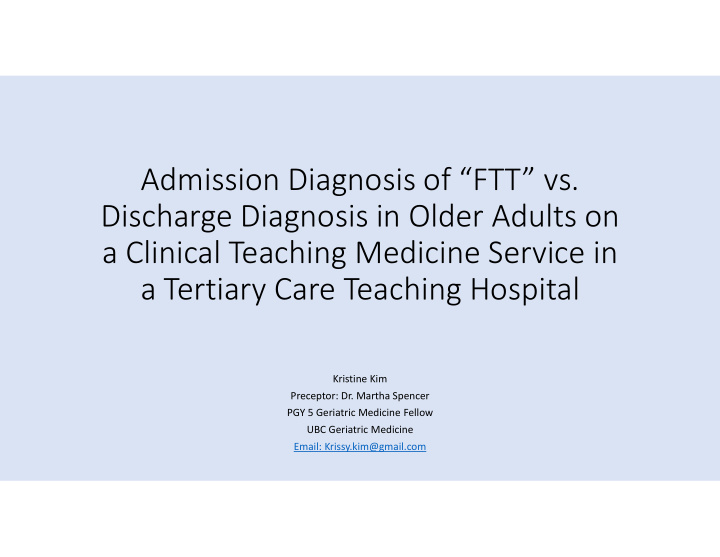



Admission Diagnosis of “FTT” vs. Discharge Diagnosis in Older Adults on a Clinical Teaching Medicine Service in a Tertiary Care Teaching Hospital Kristine Kim Preceptor: Dr. Martha Spencer PGY 5 Geriatric Medicine Fellow UBC Geriatric Medicine Email: Krissy.kim@gmail.com
Presenter Disclosure • Faculty: Kristine Kim • Relationships with financial sponsors: None
Disclosure of Financial Support • I have no financial disclosures • I have no conflicts of interest
Failure To Thrive • FTT associated w/ weight loss, PO intake, poor nutrition and inactivity (NIA) • NOT normal aging • Associated with Morbidity • Mortality Rates • Medical Care/Readmission • Institutionalization • Kumeliauskas L et al, 2013, Berkman et al, 1989, Egbert A.M, 1996, Sarkisian 1996
Current Thoughts – A quick feeler “or ‘piss poor “Better protoplasm’ ” than...Circling. ..The..Drain” “It is to avoid the sort of workup someone our age would deserve and would get. I would not give that DX to the average 70 year old. In a 90 “I prefer Wasting year old with chronic problems who took a Syndrome. The patient will sudden turn, I would rule out the obvious easy need a medical and to fix things and then use FTT. Often would neurocognitive evaluation in suspect occult malignancy , but without some "The Dwindles“ hope to find a reversible mass somewhere, need a hospice diagnosis .” “Dwindling” condition. Palliative referral is a common outcome.”
Goals of Study • To determine the disparities between the initial diagnosis of FTT and final discharge diagnosis in a clinical teaching medical service. • We propose the term FTT is being utilized when an alternative diagnosis for an underlying medical condition is determined as a diagnosis prior to discharge.
Subjects Recruited Methods (n= 94) Excluded: ‐ Concurrent Acute Retrospective cohort study Admission Diagnosis (n= 18) Tertiary university hospital (St. Paul’s Hospital) Subjects included (n=76) Excluded: ‐ Not admitted to CTU/FM (n= 1) ‐ Admitted prior Jan 1 2016 (n=1) Subjects Eligible (n=74)
Methods • Electronic Chart Review • Descriptive statistical analysis (means, proportions, ranges)
TABLE 1: Demographics Number of Age (years) patients % of patients 65 ‐ 74 22 29.7% 75 ‐ 84 27 36.5% 85+ 25 33.8% Range (y) 65 ‐ 100 Mean ± SD (y) 80 ± 9.2 Gender Female 33 45% Male 41 55%
KK1 TABLE 2: Results No. % Length of Stays (Days) patients patients 0 ‐ 14 37 50.0% P=0.03 P=0.03 15 ‐ 30 24 32.4% 30 ‐ 45 9 12.2% 45 ‐ 60 3 4.0% >60 1 1.4% Multimorbidity 0 ‐ 5 20 27.0% 6 ‐ 10 38 51.4% P<0.01 P<0.01 More than 10 16 21.6% Geriatric Consults Yes 15 20.3% No 59 79.7%
Slide 10 KK1 Kristine Kim, 4/4/2018
TABLE 3: Presentation Number of Presentation patients % of patients Acute only 57 77.0% Chronic only 15 20.3% Mixed 2 2.7% Acute vs Chronic: 77% (65.8% ‐ 86%, CI 95%) – No less than 2/3 still have an acute medical illness with 95% confidence
Diagnosis Acute Acute Chronic Reversible Non ‐ reversible Malignancy – Medication s/e (10) Dementia (9) new/metastasis (9) Infectious disease (12) Neurological Disorder (2) Cardiac Disease (11) Deconditioning (5) Malignancy ‐ Sx (2) Fractures (9) Respirology (4) GI (3) Endo (6) Renal (9) Depression (4) Delirium (5) Anxiety (1)
Diagnosis Acute Acute Chronic Reversible Non ‐ reversible Malignancy – Medication s/e (10) Dementia (9) new/metastasis (9) Infectious disease (12) Neurological Disorder (2) Cardiac Disease (11) Deconditioning (5) Malignancy ‐ Sx (2) Fractures (9) Respirology (4) GI (3) Endo (6) Renal (9) Depression (4) Delirium (5) Anxiety (1)
Diagnosis Acute Acute Chronic Reversible Non ‐ reversible Malignancy – Medication s/e (10) Dementia (9) new/metastasis (9) Infectious disease (12) Neurological Disorder (2) Cardiac Disease (11) Deconditioning (5) Malignancy ‐ Sx (2) Fractures (9) Respirology (4) GI (3) Endo (6) Renal (9) Depression (4) Delirium (5) Anxiety (1)
FTT in Discharge Diagnosis 17.6 % 17.6 % (9.7% ‐ 28.2%, CI 95%) FEWER than 1/3 contain FTT in discharge diagnosis 82.4 % FTT included Acute Medical Diagnosis
Discussion ‐ Misuse of FTT on admission in older adults • High rate of acute medical illnesses • High degree of multimorbidity • ?Delay diagnosis/medical care ‐ Further study needed • Reasons for using FTT (ie focus groups ‐ residents/ED staff) • Outcomes: morbidity/mortality • Intervention: education (residents/ED staff)
Strengths and Limitations ‐ Strengths: • Builds on current literature • Tertiary Hospital in Canada • Practical goal of leading to practice change ‐ Limitations: • Systemic bias – limited algorithmic accessibility • Small sample size • Limited to internal medicine and family medicine
Special Thanks • CGS (host) • Dr. Martha Spencer (PI) • Elena Szefer (Statistician) • Darby Thompson (Statistician)
Thank you Questions?
Recommend
More recommend